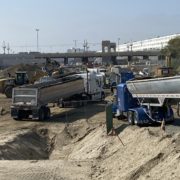Construction on State Highway – Merced, CA

Project Overview: Summit Environmental Contractors reevaluated statistical processes initially performed by a CalTrans Consultant. Summit’s analysis involved reassessing consultants four scenarios for northbound and southbound data evaluation and introducing a fifth scenario using similar statistical methodologies applied to the original total lead data evaluation. The primary objective was to systematically remove sample points with the highest concentrations of aerially deposited lead (ADL) until the upper one-sided 95% confidence limit (UCL) for total lead concentration (TTLC) was reduced below the hazardous waste criteria of 5.0 milligrams per liter (mg/L).
Location: The project spanned Childs Avenue overcrossing to Franklin Road overcrossing on State Highway 10-MER-99-R12.7/17.8 in Merced County, California.
Key Activities:
- Application of statistical methods for data reevaluation, including the use of Pro UCL statistical modeling to calculate the arithmetic means of total lead concentrations for each sampling depth.
- Examination of the correlation between total and wet lead concentrations to predict wet lead concentrations based on recalculated UCLs.
- Systematic removal of samples with the highest TTLC concentration values to achieve compliance with hazardous waste criteria.
Outcome: Summit’s statistical reevaluation successfully reduced the 95% UCL TTLC below the hazardous limit of 5.0 mg/L for specific boring locations. Consequently, the recommended total volume for removal was reduced from 10,965 cubic yards (y3) to approximately 1606.80 y3. This outcome suggests a significant potential for reducing the hazardous Type Z-2 material quantity requiring removal from the site. Summit recommends that Teichert collaborates with the owner to implement these findings and optimize the removal process.
Recommendation: Based on the findings, Summit advised the implementation of the reduced removal volume strategy. This would streamline the removal process while ensuring compliance with environmental regulations and minimizing environmental impact.



